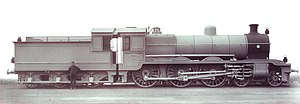| IR-Klasse HP | |||||||||||||||||||||||||||||||||||||||||||||||||||||||||||||||||||
|---|---|---|---|---|---|---|---|---|---|---|---|---|---|---|---|---|---|---|---|---|---|---|---|---|---|---|---|---|---|---|---|---|---|---|---|---|---|---|---|---|---|---|---|---|---|---|---|---|---|---|---|---|---|---|---|---|---|---|---|---|---|---|---|---|---|---|---|
 Werkfoto der Lokomotive Nr. 234, die von der North British Locomotive Company für die East Bengal Railway (EBR) 1907 gebaut wurde | |||||||||||||||||||||||||||||||||||||||||||||||||||||||||||||||||||
| |||||||||||||||||||||||||||||||||||||||||||||||||||||||||||||||||||
| |||||||||||||||||||||||||||||||||||||||||||||||||||||||||||||||||||
| |||||||||||||||||||||||||||||||||||||||||||||||||||||||||||||||||||
The HP series was a wide-gauge tender steam locomotive for heavy passenger train traffic on the railways in British India , which was built from 1906 to 1920. She is one of the BESA locomotives developed by the British Engineering Standards Committee , later called the British Engineering Standards Association (BESA). The abbreviation HP stands for Heavy Passenger.
History edit
The HP series was the locomotive intended for heavy passenger traffic, which was first proposed in the BESA standard of 1907.[1] Like the AP series , the HP was offered with three different large tenders , the small one holding 3000 gallons of water, the medium 4000 and the large 4500.
The locomotives were delivered to various railways, but only had the designation HP on the railways operated by the Indian States Railways (ISR). They were built by several British locomotive factories. Deliveries from Vulcan Foundry , Robert Stephenson and Company , North British Locomotive Company , Kitson and Company and William Beardmore and Company are documented. [2]
Later, the HPS series was created with the Schmidt smoke tube superheater system - the S stands for superheated , and the HPC series for the locomotives with superheaters converted from the HP series, where the C stands for converted.
Two HPS series locomotives have been preserved:
- HPS 30 of Bangladesh Railway in Rajshahi
- HPS 24467 of the Indian Railways at the National Rail Museum of India, New Delhi .
-
Variant with 3000 gallon tender
-
Variant with 4000 gallon tender
-
Variant with 4500 gallon tender
-
Preserved superheated HPS variant of the Bangladesh Railway
-
Preserved superheated HPS variant in the National Rail Museum of India
Technical edit
The locomotive was a two-cylinder wet steam engine with a Belpaire boiler . The grate was arranged between the coupling gear sets, for which the wheel base between axles 2 and 3 was increased. The cylinders were arranged on the outside and the drive was on the second axle. The engine had a Heusinger control with a flat slide in the wet steam variants; piston slides were used in the superheated steam variant. The circulating plate was arranged low, so that wheel protection boxes had to be arranged above the coupling wheel sets. As with the AP series locomotives, the line of the driver's cab floor is raised in an arc to the height of the circulation plate. A small cow catcher was attached to the front buffer beam . The driver's cab was completely closed, with the rear wall of the driver's cab being formed by the three-axle tender. The three-axle tender was equipped with running boards and handrails along the side walls, which made it possible to reach the train from the locomotive while in motion. [3]
Weblinks edit
References edit
- ^ "British Designs (1905 -1928)". Development of Steam Locomotive Design in India. Heritage Directorate, Indian Railways. Retrieved 2020-08-22.
- ^ "Great Indian Peninsula 4-6-0 Locomotives in India". steamlocomotive.com. Retrieved 2020-08-31.
- ^ J. Stuart (1907). "North British Locomotive Company Glasgow (NBL) L294, Indian State Railway (ISR)-East Bengal Railway 234" (in German). Retrieved 2020-08-31.
Category:Steam locomotives of India Category:5 ft 6 in gauge locomotives Category:0-6-0 locomotives Category:Vulcan Foundry locomotives Category:Robert Stephenson and Hawthorns locomotives Category:Freight locomotives Category:Passenger locomotives Category:Scrapped locomotives